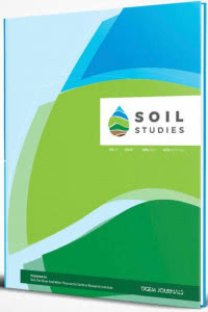Fractions of heavy metals in the soil after the application of municipal sewage sludge, peat and furnace ash
Municipal sewage sludge, peat, furnace ash, soil, heavy metals, speciation
Fractions of heavy metals in the soil after the application of municipal sewage sludge, peat and furnace ash
___
Antonkiewicz J. 2007. The influence of various ash-and- sludge and ash-and-peat mixtures on yield and elements content in grass-birdsfoot-trefoil mixture. Part II. Heavy metals. Zesz. Probl. Post. Nauk Roln. 520, 265-278.Antonkiewicz J. 2008. Influence of municipal sewage sludge incineration ash, peat and their mixtures on physicochemical properties and the heavy metals content in soil. Soil Science Annual, 59, 1, 18-28.
Antonkiewicz J. 2011. Assessment of bioavailability of heavy metals in wastes used for biological reclamation of hazardous waste landfill. Zesz. Nauk. UR w Krakowie, 484, seria Rozprawy z. 358: 119 pp.
Dąbrowska L., Rosińska A., Janosz-Rajczyk M. 2011. Heavy metals and PCBs in sewage sludge during thermophilic digestion process. Archives of Environmental Protection, 37, 3, 3-13.
Gawdzik J. 2012. Mobility of heavy metals in sewage sludge for example wastewater treatment plant. Inżynieria i Ochrona Środowiska, 15, 1, 5-15.
Gworek B., Mocek A., Kondzielski I. 2006. Speciation of copper in industrialny polluted soils – a comparison of two sequential extraction methods. Polish J. Environ. Stud. Vol. 15, No. 2a (2006), 295-303.
Kabata-Pendias A., Piotrowska M., Motowicka-Terelak T., Maliszewska-Kordybach T., Filipiak K., Krakowiak A., Pietruch Cz. 1995. Podstawy oceny chemicznego zanieczyszczenia gleb - metale ciężkie, siarka i WWA. Państwowa Inspekcja Ochrony Środowiska. Bibliot. Monit. Środ., Warszawa, ss. 41.
Kalembkiewicz J., Sočo E. 2004. Sequential extraction of Cr, Fe, Co, and Ni from industrial ash. Ecolog. Chem. and Engin. 11, 4-5, 347-352.
Papadimitriou C.A., Haritou I., Samaras P., Zouboulis A.I. 2008. Evaluation of leaching and ecotoxicological properties of sewage sludge-fly ash mixtures. Environmental Research, 106, 340-348.
Regulation. 2010. Rozporządzenie Ministra Środowiska z dnia 13 lipca 2010 r. w sprawie komunalnych osadów ściekowych. Dz. U. RP, Nr 137, poz. 924.
Rosik-Dulewska Cz. 2000. Sanitation of wastewater sludge with mineral wastes as metals speciation forms. Archiv. Environ. Protect., 26, 3, 29-42.
Rosik-Dulewska C., Głowala K., Karwaczyńska U., Robak J. 2008. Elution of heavy metals from granulates produced from municipal sewage deposits and fl y-ash of hard and brown coal in the aspect of recycling for fertilization purposes, Archives of Environmental Protection, 34 (2), 63−72.
Samaras P., Papadimitriou C.A., Haritou I., Zouboulis A.I. 2008. Investigation of sewage Sludge stabilization potential by the addition of fly ash and lime. Journal of Hazardous Materials, 154, 1052-1059.
Sienkiewicz S., Czarnecka M.H. 2012. Content of available Cu, Zn and Mn in soil amended with municipal sewage sludge. J. Elem. 17(4), 649-657
Systematics of Polish Soils. PTG. 1989. Roczn. Glebozn., 40, 3/4, 1-150.
Tessier A., Campbell P.G.C., Bisson M. 1979. Sequential extraction procedure for the speciation of particulate trace metals. Analytical Chemistry, vol. 51, 7, 844-851.
Wojcieszczuk T., Meller E., Sammel A., Stankowski S. 2009. The content and dissolubility of some chemical components in coal ashes of different origin. Zesz. Probl. Post. Nauk Roln., 535, 483-493.
- ISSN: 2146-7072
- Yayın Aralığı: 2
- Yayıncı: Toprak Gübre ve Su Kaynakları Merkez Araştırma Enstitüsü
Amina Richa, Abdelkader Douaoui, Naima Bettahar
The quality of water used for irrigation of agricultural soil in the basin of Kolubara river
Radmila Pivic, Zoran Dinic, Dragana Josic, Aleksandra Stanojkovic Sebic
Jacek Antonkiewicz, Robert Pelka, Agnieszka Kowalewska
İmre VAGO, Marianna SİPOS, Laszlo TOLNER, İmre CZİNKOTA, Gergely SZİLAGYİ, İbrahim ISSA, Janos KATAİ
Ali Şenlikci, Mustafa Doğu, Emel Eren, Ebru Çetinkaya, Sevinç Karadağ
Soil microbial biomass and gas-production activity (CO2) in Chernozems of different land use
Kristina Ivashchenko, Nadezhda Ananyeva, Vyacheslav Vasenev, O. Ryzhkov, V. Kudeyarov, R. Valentini
Abdelkader DOUAOUİ, İbrahim YAHİAOUİ
Study of classification and estimation models for soil loss disturbed by engineering construction
Duihu NİNG, Xiaoying LİU, Pengfei DU
Soil erosion and conservation in two geomorphic and recreational environments
Cengiz Kaya, Osman Sönmez, Muhammed Ashraf, Tahir Polat, Levent Tuna, Salih Aydemir
